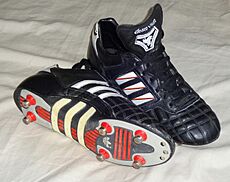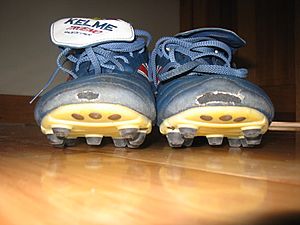Cleat (shoe) facts for kids
Cleats or studs are small bumps or blades found on the bottom of shoes. They help you get a better grip on soft or slippery surfaces, like grass or ice. Cleats can be shaped like cones or blades and are made from materials like plastic, rubber, or metal. The type of cleat you wear depends on where you're playing, such as on grass, ice, or artificial turf.
In America, people often call the whole shoe with these bumps "cleats." In other English-speaking countries, especially for sports like football (soccer), these shoes are usually called "boots."
Contents
The Story of Cleats
People have probably used cleats for a very long time! It's believed that even Roman legionaries, who were ancient Roman soldiers, wore sandals with studs on the bottom. These sandals, called caligae, were heavy military boots with nails in the soles. They helped soldiers get a good grip while marching.
Athletes have worn shoes with special grips since at least the 1500s. The first time we read about "football boots" was in 1526. King Henry VIII of England asked his shoemaker, Isaac Ali, to make him a special pair of boots "to play football." These boots cost about four shillings, which would be around $200 today! They were likely made from very strong leather.
Football became very popular in England. When The Football Association was formed in 1863, the sport became more organized. This led to a need for better equipment to keep players safe and comfortable. Around the 1840s, a new way to make rubber stronger was invented. This process is called vulcanization.
Vulcanized rubber is used in many types of shoes, but it's especially good for cleats. It helps protect a player's feet. By the 1890s, studs were being added to football cleats. Other sports also started using spiked shoes. For example, a British company (now known as Reebok) made some of the first spiked leather running shoes in the 1890s.
In the United States, cleats started to be used in the 1860s for baseball shoes. The first official baseball shoe was made in 1882 by Waldo M. Claflin. Cleats became even more popular with the start of American football in the early 1900s. At first, football players wore baseball shoes, but soon new designs appeared. In the 1920s, cleats that you could take off and put back on were invented. As sports fields changed, especially with artificial turf, cleats had to change too. By the 1970s, players wore shoes with short, rubber cleats for turf fields.
Cleat technology kept getting better. In 1954, Adidas made modern football boots that were lighter. They had a non-leather sole and used kangaroo leather for the top part. These boots also had replaceable rubber or plastic studs that could be screwed in at different lengths. In the 1990s, Adidas introduced rubber blades instead of round studs. These blades faced different directions for even better grip. Today, you can find different cleats for different surfaces: aluminum cleats for wet dirt, firm plastic cleats for regular fields, and short plastic or rubber cleats for very hard surfaces.
Different Types of Cleats
Firm Ground Cleats
Firm ground cleats are made for natural surfaces like dirt and grass. They have large studs on the bottom to help you grip the ground. These studs are usually permanently attached to the shoe. The studs themselves are often called cleats. For Association football (soccer), there are three main types of boots: round, hard ground, and bladed. Sometimes, studs are made of metal, but this is less common because metal studs can be dangerous and are not allowed in some sports.
Soccer Cleats

In soccer, the shoes are called football boots. There are three main cleat types:
- Soft ground cleats are for wet, muddy weather. These cleats are always replaceable and are almost always metal. This makes them easy to change when they wear out.
- Firm ground cleats are for firm, natural fields.
- Bladed cleats have flat, blade-like studs for good grip.
In the UK, "cleats" are known as "studs." A "sliding tackle" is when a player slides to get the ball. It can be dangerous if metal studs hit an opponent's legs.
American Football Cleats
In the USA, Joseph Pipal, a college football coach, helped create "mud cleats" for football shoes. Early cleat makers included Gola (1905), Valsport (1920), and Hummel (1923). In 1925, brothers Adolf Dassler and Rudolf Dassler made football cleats with replaceable metal studs. After a disagreement, these brothers went on to create two huge sports companies: Puma and Adidas.
In 1929, Riddell made important changes to football cleats. They designed the sole with a steeper angle for a "snug fit" and "maximum traction." Today, many players prefer molded cleats because they are more comfortable. However, they can't be changed for different field conditions. Players might choose molded cleats or removable stud cleats depending on if they play on grass or artificial turf. Removable studs can be longer and give better grip on grass. Cleats are an important part of Protective equipment in gridiron football. Big brands like Nike, Adidas, and Under Armour make football cleats today.
Australian Football Cleats
In Australia, the studs on Australian rules football boots are called "stops." Before modern plastic soles, these were often wooden studs that screwed into the boot. In 1889, there were two types of stops: one screwed in, and another was fixed with nails.
Baseball Cleats
In baseball, cleats are also called "spikes." They are usually rectangular and can be made of rubber, plastic, or metal.
- Rubber cleats have grooves and smaller bumps in the middle, with soft rubber spikes around the edges.
- Plastic cleats are similar but have a hard bottom and thick, hard plastic spikes. These spikes are usually where the toes and ball of the foot hit the ground.
- Metal spikes are like plastic spikes but are thin pieces of metal. They dig into grass and sand easily for better grip.
Rubber and plastic cleats are used in youth baseball, and metal cleats are usually not allowed. Metal spikes are mostly used in higher levels of the sport, like high school, college, and professional baseball. In 1984, metal spikes were banned in American high school baseball because of injuries, but the ban was lifted in 1989. More professional players, even in Major League Baseball (MLB), are now using plastic spikes. They are lighter and spread weight better, which can help players feel less tired during the season.
In 2018, Major League Baseball stopped requiring players' cleats to mostly be their team's main colors.
Lacrosse Cleats
Lacrosse cleats often have high ankle support, similar to American Football cleats. This raised ankle support helps players with quick stops, starts, and changes in direction, which happen a lot in lacrosse. Lacrosse cleats also have a toe cleat at the front for pushing off and gaining speed. Unlike American Football cleats, lacrosse cleats have their spikes more towards the edges of the foot sole.
Detachable Cleats
Detachable cleats are shoes where the studs can be removed. You can usually screw or attach metal or plastic pieces to the bottom of the shoe.
Cycling Cleats
A special metal or plastic piece that attaches to the bottom of a cycling shoe is called a cleat. This cleat connects the shoe securely to a clipless pedal system. When you press your shoe onto the pedal, the cleat locks into place. You can release it by twisting your foot sideways.
Ice Cleats
Ice cleats or crampons are spikes that attach under your shoes to stop you from slipping, especially on ice. Some variations use rubber bands or a fixed mount at the front of the heel, making them easy to take off when you don't need them.
Removable Football Studs
On soft, wet, or muddy ground, soccer players often choose removable studs. These are usually metal cones that are longer than regular soccer studs. They are added to the rubber or plastic studs already on the boot. These longer, more aggressive studs help players get a better grip in slippery conditions.
Golf Shoes
Many golfers wear spiked shoes. In the past, metal spikes were common. However, many golf courses now require "soft spikes," which are usually made of plastic.
Logger Boots (Calks)
Logging boots have several spikes attached to their soles. These spikes are generally still made of metal.
Artificial Ground Cleats
Artificial Ground cleats are made mainly for man-made surfaces, like artificial turf or running tracks.
Baseball and Softball Turf Shoes
While regular cleats can be used on turf, special baseball and softball turf shoes are also made. These shoes usually have many small rubber studs along the soles instead of spikes.
American Football Turf Cleats
Many football cleats today can be used on both artificial turf and natural grass. However, many molded cleats are designed to work best on artificial turf. Molded cleats usually give better grip on artificial surfaces. Detachable studs can sometimes be too thick for artificial turf and might not provide enough grip.
Soccer Turf Shoes
Turf shoes for Association football (soccer) have the same top part as regular football boots. But their outsoles, which are the "cleat" part, are different. They have small rubber studs or raised bumps that give just enough grip on flat artificial turf. They are very durable because they are more like an extension of the rubber sole itself.
Track Spikes
Track spikes are placed on the bottom of running shoes to help runners get more grip and go faster. While you can find removable spikes, most runners prefer fixed spikes. These spikes come in different materials. They were first made of metal because it was strong. Later, during the World War, German engineers tried using canvas and rubber spikes to find lighter materials. Today, most track spikes are made of plastic. Plastic is cheap and can be molded into many shapes. This is important because spikes need different shapes for different running surfaces.
- Needle spikes (3/16") are used on all-weather tracks.
- Christmas tree spikes (1/4") are common on many surfaces.
- Pyramid spikes are used for cross country running.
- Tartan spikes (1/4") are mostly used on rubber tracks.
See also
- Comparison of orthotics



